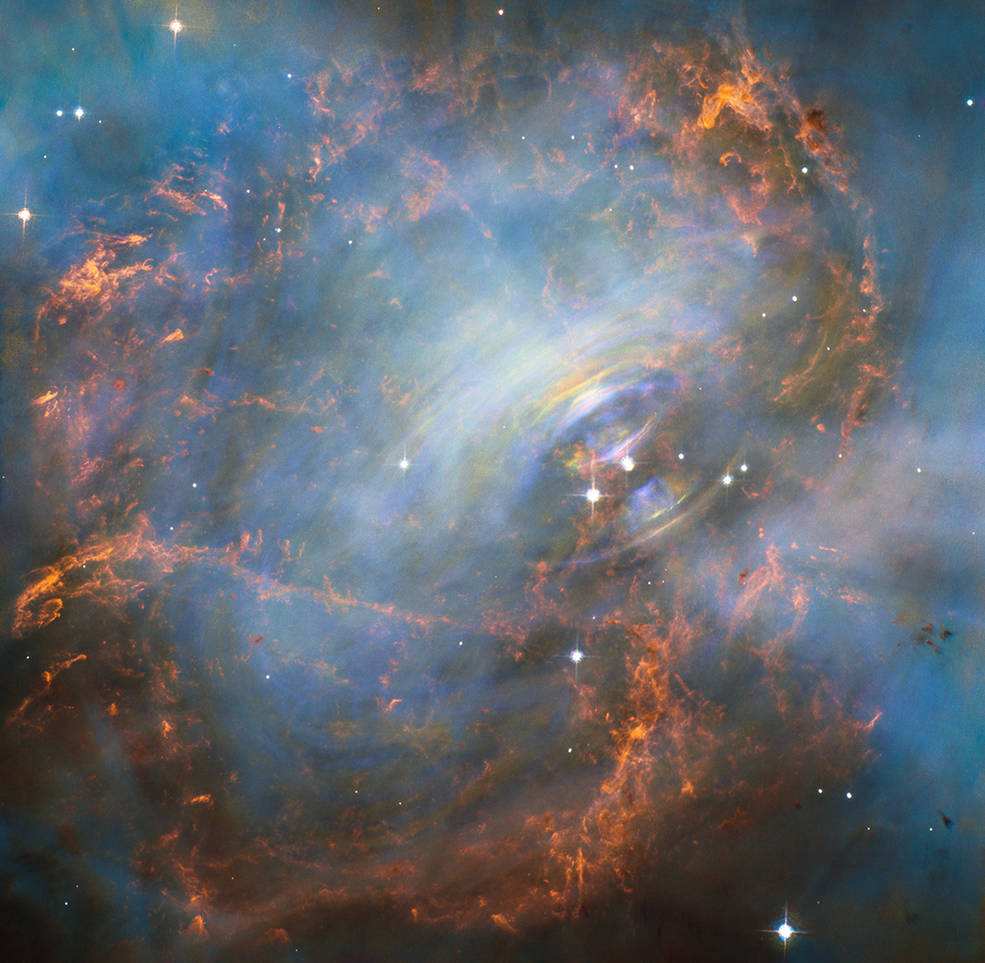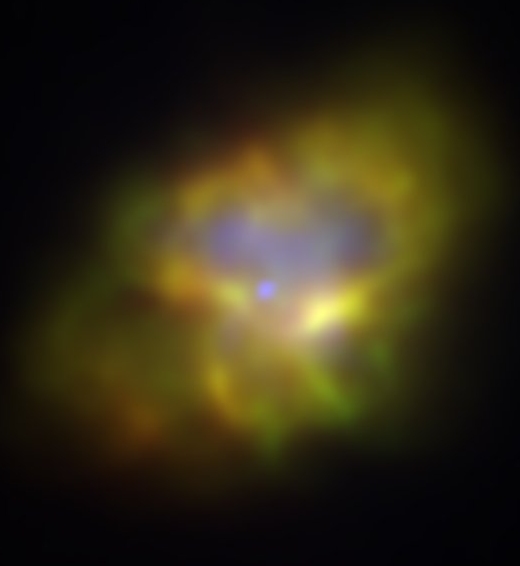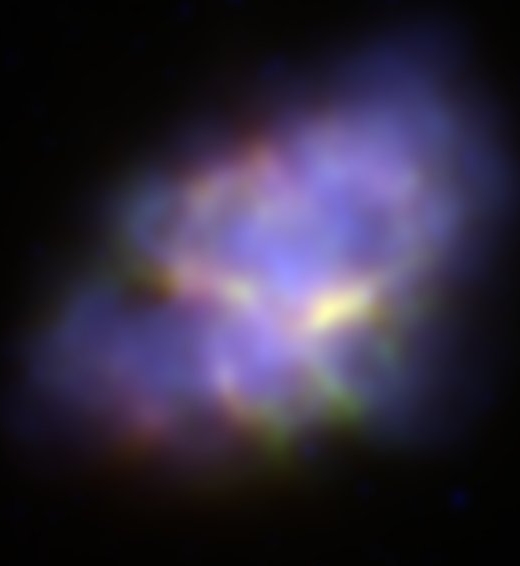It looks like you're using an Ad Blocker.
Please white-list or disable AboveTopSecret.com in your ad-blocking tool.
Thank you.
Some features of ATS will be disabled while you continue to use an ad-blocker.
12
share:
www.nasa.gov...

Its hard to believe this image is real... Pretty incredible!
I don't know what else to say...
its Stunning!
Peering deep into the core of the Crab Nebula, this close-up image reveals the beating heart of one of the most historic and intensively studied remnants of a supernova, an exploding star. The inner region sends out clock-like pulses of radiation and tsunamis of charged particles embedded in magnetic fields.
The neutron star at the very center of the Crab Nebula has about the same mass as the sun but compressed into an incredibly dense sphere that is only a few miles across. Spinning 30 times a second, the neutron star shoots out detectable beams of energy that make it look like it's pulsating.
The NASA Hubble Space Telescope snapshot is centered on the region around the neutron star (the rightmost of the two bright stars near the center of this image) and the expanding, tattered, filamentary debris surrounding it. Hubble's sharp view captures the intricate details of glowing gas, shown in red, that forms a swirling medley of cavities and filaments. Inside this shell is a ghostly blue glow that is radiation given off by electrons spiraling at nearly the speed of light in the powerful magnetic field around the crushed stellar core.
The neutron star is a showcase for extreme physical processes and unimaginable cosmic violence. Bright wisps are moving outward from the neutron star at half the speed of light to form an expanding ring. It is thought that these wisps originate from a shock wave that turns the high-speed wind from the neutron star into extremely energetic particles.
When this "heartbeat" radiation signature was first discovered in 1968, astronomers realized they had discovered a new type of astronomical object. Now astronomers know it's the archetype of a class of supernova remnants called pulsars - or rapidly spinning neutron stars. These interstellar "lighthouse beacons" are invaluable for doing observational experiments on a variety of astronomical phenomena, including measuring gravity waves.
Observations of the Crab supernova were recorded by Chinese astronomers in 1054 A.D. The nebula, bright enough to be visible in amateur telescopes, is located 6,500 light-years away in the constellation Taurus.

Its hard to believe this image is real... Pretty incredible!
I don't know what else to say...
its Stunning!
Is stunning. Thankyou
But only real if we can see in all spectrums...not quite. These composites do help us visualise what is going on though.
I do find those ring type structures strange though. Most probably a touch up job.
But only real if we can see in all spectrums...not quite. These composites do help us visualise what is going on though.
I do find those ring type structures strange though. Most probably a touch up job.
edit on 8-7-2016 by GemmyMcGemJew because: (no reason
given)
a reply to: GemmyMcGemJew
Well.. its on NASA's site... Im no Astrophysicist
But i do have a new screen saver
Well.. its on NASA's site... Im no Astrophysicist
But i do have a new screen saver
Beutiful.
But I have to imagine how much gold spewed out of the blast.
But I have to imagine how much gold spewed out of the blast.
Many more startling revelations are waiting to be unravel. Science continues its leap
This is 6.5 thousand light years from earth
Looks like a pressure wave thats light years in diameter!
Looks like a pressure wave thats light years in diameter!
originally posted by: Gothmog
And possibly a new Black Hole is born
No, a neutron star is born.
Well, was born. It is 962 years old now... Still a newborn in astronomical time scale though.
Neutron stars and black holes are two different things, although a neutron star dense enough could collapse into a black hole.
Fun fact: neutron stars are so dense that their size is only several dozen miles across (smaller than a moon), and a matchbox filled with neutron stars material would weight 13 million tons.
a reply to: swanne
I am familiar with the difference . A star that contains enough heavy metals at the core goes supernova. And if that star is of the right type , it begins to collapse upon itself. Neutron stars , per new theories , are created in a different manner.
Per NASA , HubbleSite , my knowledge , etc
HubbleSite
I am familiar with the difference . A star that contains enough heavy metals at the core goes supernova. And if that star is of the right type , it begins to collapse upon itself. Neutron stars , per new theories , are created in a different manner.
When a very massive star exhausts its nuclear fuel it explodes as a supernova. The outer parts of the star are expelled violently into space, while the core completely collapses under its own weight.
Per NASA , HubbleSite , my knowledge , etc
HubbleSite
Great stuff! I love this stuff.Going over the images over on the Hubble site.Looking forward to more!
That's a fantastic image. The energetic nebula around that neutron star looks like a spinning top.
I just had a go at making some composite images of this nebula using data at skyview.gsfc.nasa.gov... although of course the end result isn't as detailed as the Hubble images.
Here's one, using infrared images from the WISE telescope (represented by red and green colours), and ROSAT X-ray telescope (represented by blue colour):

And here's just the WISE imagery:

Redder colours here represent longer and less energetic infrared wavelengths, while bluer colours are shorter and more energetic infrared wavelengths.
I just had a go at making some composite images of this nebula using data at skyview.gsfc.nasa.gov... although of course the end result isn't as detailed as the Hubble images.
Here's one, using infrared images from the WISE telescope (represented by red and green colours), and ROSAT X-ray telescope (represented by blue colour):

And here's just the WISE imagery:

Redder colours here represent longer and less energetic infrared wavelengths, while bluer colours are shorter and more energetic infrared wavelengths.
new topics
-
In four years, you don’t have to vote again.
2024 Elections: 1 hours ago -
Prize or Zonk
General Chit Chat: 4 hours ago -
I've realized something about Politics recently.
US Political Madness: 5 hours ago -
France bans head coverings but allows Christianity to be mocked at Olympics.
Political Conspiracies: 7 hours ago -
Woo time it aint over yet
Paranormal Studies: 8 hours ago -
BIDEN-HARRIS Preparing to Also Make Us Pay For Illegal-Aliens to Attend College Prep Programs.
Political Ideology: 11 hours ago
top topics
-
The Main Question and A Bonus Question
General Conspiracies: 13 hours ago, 13 flags -
Is Kamala Good for America ?
Political Issues: 13 hours ago, 12 flags -
BIDEN-HARRIS Preparing to Also Make Us Pay For Illegal-Aliens to Attend College Prep Programs.
Political Ideology: 11 hours ago, 9 flags -
Did Russia just attack a NATO nation?
The Gray Area: 16 hours ago, 6 flags -
The Most Crime Ridden Games Ever
World Sports: 14 hours ago, 6 flags -
In four years, you don’t have to vote again.
2024 Elections: 1 hours ago, 5 flags -
A Preliminary Question
General Conspiracies: 14 hours ago, 3 flags -
Olympics France 2024 Opening Ceremony
World Sports: 14 hours ago, 3 flags -
Woo time it aint over yet
Paranormal Studies: 8 hours ago, 3 flags -
France bans head coverings but allows Christianity to be mocked at Olympics.
Political Conspiracies: 7 hours ago, 2 flags
active topics
-
JD Vance Is the Least Liked VP Nominee in Decades, According to Polls
2024 Elections • 341 • : network dude -
France bans head coverings but allows Christianity to be mocked at Olympics.
Political Conspiracies • 24 • : frogs453 -
Remember that picture of Trumps fist in the air and blood on his face?
Education and Media • 237 • : ArMaP -
In four years, you don’t have to vote again.
2024 Elections • 11 • : network dude -
The Acronym Game .. Pt.4
General Chit Chat • 145 • : SecretKnowledge2 -
Shots Fired At Trump Rally Trump Looks Wounded
US Political Madness • 1849 • : daskakik -
The Most Crime Ridden Games Ever
World Sports • 6 • : SecretKnowledge2 -
Olympics France 2024 Opening Ceremony
World Sports • 11 • : putnam6 -
I've realized something about Politics recently.
US Political Madness • 7 • : wAnchorofCarp -
Prediction watch how fast the war in Ukraine ends.
Dreams & Predictions • 65 • : annonentity
12
